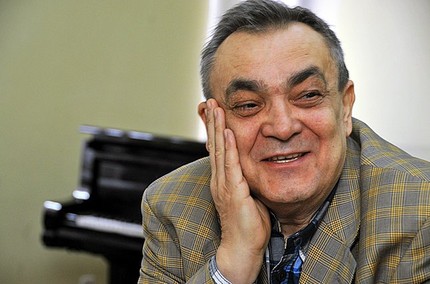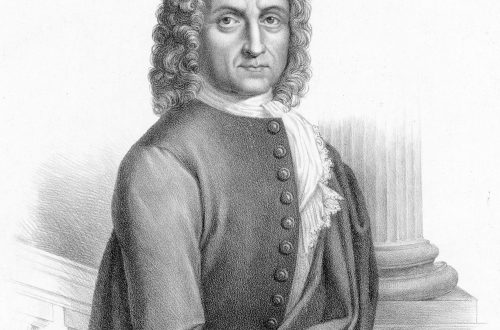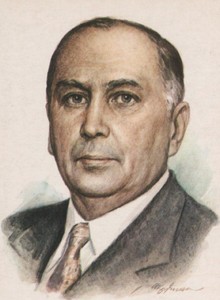
Evgeny Fyodorovich Stankovych |
Yevhen Stankovych

In the galaxy of Ukrainian composers of the 70s. E. Stankovich is one of the leaders. Its originality lies, first of all, in large-scale ideas, ideas, coverage of the problems of life, their musical embodiment, and finally in a civic position, in a consistent upholding of ideals, in a struggle (not figurative – genuine!) with music officials.
Stankevich is referred to as a “new folklore wave”. This is probably not entirely true, because he does not regard folklore as a means of embodying this or that image. For him it is a form of existence, a vital attribute. Hence the generous use of folk themes and images, refracted through the prism of the modern vision of the world in all its complexity, versatility, and inconsistency.
Stankovich was born in the small Transcarpathian town of Svalyava. Music school, music school, service in the ranks of the Soviet Army. After demobilization, he becomes a student at the Kyiv Conservatory (1965). For 3 years of studying in the class of B. Lyatoshinsky, Stankovich managed to imbue his highly moral principle: to be honest both in art and in actions. After the death of the teacher, Stankovich moved to the class of M. Skorik, who gave an excellent school of professionalism.
Everything in music is subject to Stankovich. He owns all modern types of composing technique. Dodecaphony, aleatoric, sonorous effects, collage are organically used by the composer, but nowhere do they become a self-sufficient goal.
Since his student years, Stankovich has been writing a lot and in a variety of fields, but the most significant works were created in the symphonic and musical-theatrical genres: Sinfonietta, 5 symphonies, the ballets Olga and Prometheus, the folk opera When the Fern Blooms – these and other works are marked by original, peculiar features.
The first symphony (“Sinfonia larga”) for 15 string instruments (1973) is a rare case of a one-movement cycle in a slow tempo. These are deep philosophical and lyrical reflections, where Stankovich’s gift as a polyphonist was clearly manifested.
In the galaxy of Ukrainian composers of the 70s. E. Stankovich is one of the leaders. Its originality lies, first of all, in large-scale ideas, ideas, coverage of the problems of life, their musical embodiment, and finally in a civic position, in a consistent upholding of ideals, in a struggle (not figurative – genuine!) with music officials.
Stankevich is referred to as a “new folklore wave”. This is probably not entirely true, because he does not regard folklore as a means of embodying this or that image. For him it is a form of existence, a vital attribute. Hence the generous use of folk themes and images, refracted through the prism of the modern vision of the world in all its complexity, versatility, and inconsistency.
Stankovich was born in the small Transcarpathian town of Svalyava. Music school, music school, service in the ranks of the Soviet Army. After demobilization, he becomes a student at the Kyiv Conservatory (1965). For 3 years of studying in the class of B. Lyatoshinsky, Stankovich managed to imbue his highly moral principle: to be honest both in art and in actions. After the death of the teacher, Stankovich moved to the class of M. Skorik, who gave an excellent school of professionalism.
Everything in music is subject to Stankovich. He owns all modern types of composing technique. Dodecaphony, aleatoric, sonorous effects, collage are organically used by the composer, but nowhere do they become a self-sufficient goal.
Since his student years, Stankovich has been writing a lot and in a variety of fields, but the most significant works were created in the symphonic and musical-theatrical genres: Sinfonietta, 5 symphonies, the ballets Olga and Prometheus, the folk opera When the Fern Blooms – these and other works are marked by original, peculiar features.
The first symphony (“Sinfonia larga”) for 15 string instruments (1973) is a rare case of a one-movement cycle in a slow tempo. These are deep philosophical and lyrical reflections, where Stankovich’s gift as a polyphonist was clearly manifested.
Completely different, conflicting images permeate the Second (“Heroic”) Symphony (1975), overshadowed, in the words of the composer, by the “fiery sign” of the Great Patriotic War.
In 1976, the Third Symphony (“I Am Affirmed”) appears – an epic-philosophical large-scale six-part symphonic canvas, in which the choir is introduced. A huge wealth of images, compositional solutions, rich musical dramaturgy distinguish this work, culminating in the evolution of Stankovich’s work. The contrast of the Third is the Fourth Symphony, created a year later (“Sinfonia lirisa”), the artist’s reverent lyrical statement. Finally, the last, Fifth (“Pastoral Symphony”) is a poetic lyrical confession, reflections on nature and the place of man in it (1980). Hence short motifs-chants and direct folklore signs, rare for Stankovich.
Along with large-scale ideas, Stankevich often turns to chamber statements. Miniatures, designed for a small group of performers, enable the composer to convey instant mood changes, work out the smallest details of structures, illuminate images from different angles and, thanks to genuine skill, create perfect compositions, perhaps about the most intimate. (The level of perfection is also evidenced by the fact that in 1985 the UNESCO Music Commission named Stankovic’s Third Chamber Symphony (1982) among the 10 best compositions in the world.)
Stankovich is also attracted by musical theater, above all by the opportunity to touch history. The folk-opera When the Fern Blooms (1979) is unusual in its conception. This is a series of genre-domestic and ritual scenes intended for concert performance by the world-famous State Ukrainian Folk Choir. G. Ropes. In an organic combination of authentic folklore samples and author’s music: a kind of musical dramaturgy is born – without a through plot, close to suite.
Other systems of material organization were found in the ballets Olga (1982) and Prometheus (1985). Major historical events, diverse images and storylines feed the ground for the implementation of grandiose musical performances. In the music of the ballet “Olga” various storylines give rise to a variety of ideas: here there are heroic-dramatic scenes, tender love scenes, and folk ritual scenes. This is, perhaps, the most democratic composition by Stankovich, because, like nowhere else, the melodic beginning is widely used here.
Other in Prometheus. Unlike the cross-cutting plot of “Olga”, there are 2 planes here: real and symbolic. The composer undertook the most difficult task: to embody the theme of the Great October Socialist Revolution by musical means.
He was helped to avoid banality, straightforwardness, and clichés not only by the romantic interpretation of symbolic images (Prometheus, his daughter Iskra), but, first of all, by an extraordinary development of themes, a modern language without allowances for the laws of the genre. The musical solution turned out to be much deeper than the outer row. Especially close to the composer is the image of Prometheus, who brought good to mankind and is doomed to suffer forever for this act. The plot of the ballet is also beneficial in that it made it possible to push two polar worlds together. Thanks to this, a highly conflicted composition arose, with powerful upsurges of dramatic and lyrical, sarcasm and genuine tragedy.
“To sharpen the “human in a person”, to make his emotional world, his mind easily respond to the “call signs” of other people. Then the mechanism of participation, empathy will not only allow you to perceive the essence of the work, but will definitely aim the listener at the problems of today. This statement by Stankovych accurately denotes his civic position and reveals the meaning of his active social activity (secretary of the Union of Composers of the USSR and first secretary of the Union of Composers of the Ukrainian SSR, deputy of the Supreme Soviet of the Ukrainian SSR, people’s deputy of the USSR), the purpose of which is to do good.
S. Filstein





